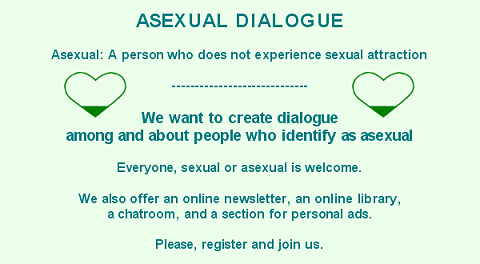|
最近數年來,另一種族群組織也已經設法作為性少數而組織起來,這個族群就是“無性者(asexual)”。
從生物學上看,“無性的(asexual)”這個詞語的意思是“無性徵的、缺乏性興趣的、無性行為的(sexless)”,即指沒有性器官或無性活動的意思。例如,傳統的典型用法是這樣表達的——“無性生殖(asexual
reproduction)”(無性生殖在微生物中是普遍存在的,除此以外,在一些植物中、甚至在少數動物中也存在)。
不過,在這個新興權利運動中活躍的個人是一些在生理上健康的人,他們用一個新的定義來界定自己,即:無性者是指對任何類型的性行為沒有任何興趣的人,也指對他人沒有性吸引力的人。一些激進人士由於拒絕被人貼上性紊亂(sexual
disorder)的標籤,他們宣稱無性就是一種性取向或者就是一種單獨的性別認同[1],不過,這遭到了其他人的阻攔或反對。不管怎樣,許多無性者感到自己被忽視了,被誤解了,而且在一定程度上感到自己受到了壓制,因為他們周圍的社會並沒有把他們當一回事兒。無性者設法通過數量上取得優勢的方法,希望逃避要適應社會環境的壓力。這種潛在的性少數族群的規模究竟有多大,終歸是所有人想要猜出來的謎底。一項研究估計大約占人口的1%,不過在這樣的資料被證實之前,尚要做更深入的探討[2]。
不管怎樣,像人類許多其它的性現象一樣,無性只是一個程度的問題。一些把自己描述成無性的人畢竟可能有一定程度的性興趣。照現在這個程度的理解看,這個術語涵蓋了差異非常大的各種現象,從性厭惡、性欲缺乏或性欲低下到性欲壓抑、性偏好或完全的性壓抑,不一而足。一些人也許只是在性生理方面發育遲緩。甚至,年齡也可能成為自稱為無性者的一個重要的因素。單憑這個原因來看,要獲得無性者的精確人數也是一件困難的事情。出於同樣的原因,有人可能會懷疑作為性少數的無性者的組織最終是否會獲得成功。

無性者組織的典型的網站
上圖是合併了的兩個不同的無性者組織的網站首頁。(為了避免被輕易識破,廣告中這些場所的名稱及其它細節內容已經有所改變,但是其活動的內容則確定無疑。)
|
|
In recent years, still another group has been trying to organize as a sexual minority - the “asexuals”.
In biology, the word “asexual” means “sexless”, i.e. it refers to the absence of sex organs or sexual activity. A typical traditional use, for example, is the expression “asexual reproduction” (it is common in micro-organisms, but occurs also in some plants and even in a few animals).
However, the individuals active in this new movement are physically healthy human beings who apply a new definition to themselves:
Asexuals are individuals who have no interest in sexual intercourse of any kind and do not feel sexually attracted to others. Rejecting the label of a sexual disorder, certain activists claim that asexuality is a distinct sexual orientation or a separate gender identity, but this is disputed by others. In any case, many asexuals feel ignored, misunderstood, and, to a certain degree, even
oppressed, since the world around them does not take them seriously. By trying to find strength in numbers, they hope to escape the pressure to conform. How large such a potential minority might turn out to be is anybody’s guess. One study has estimated ca. 1% of the population, but it will take much more research before such a figure can be confirmed
1.
In any case, asexuality is, like much else in human sexuality, a matter of degree. Some self-described asexuals may have some limited sexual interests after all. As it is now, the term covers very different things, from sexual aversion and absent or low sexual desire to inhibition and partial or complete repression. Some individuals may simply be delayed in their physical development. Indeed, age may be an important factor. For this reason alone it is difficult to arrive at precise figures. By the same token, one may doubt that the organization of asexuals as a minority will be successful in the long run.

Typical web site of an asexual organization
The above is a blend of two different asexual home pages.
(In order to avoid easy identification, the name, the overall design and various details have been changed or omitted, but the content as such is authentic.)
1. Bogaert, Anthony F. (August 2004). "Asexuality: prevalence and associated factors in a national probability sample". Journal of Sex Research 41 (3): 279-81.
|